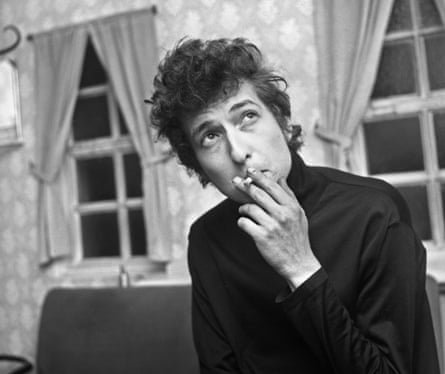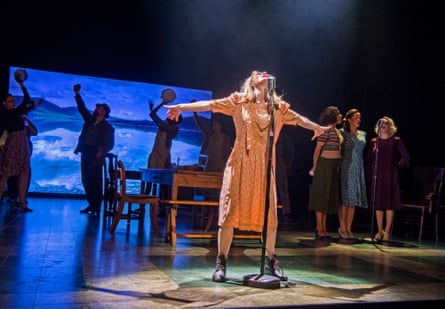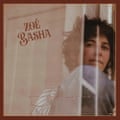Todd Almond (actor in Broadway transfer): The song Like a Rolling Stone arrives at the end of Act One of Girl from the North Country, and although different from the majority of the show’s songs in that it was a recognisable Dylan hit, it stands as a great example of how the music functions in the show overall.
Shirley Henderson (sang the song in the original London production): I knew some of the songs but I had never listened to them the way I finally listened to them. That sweetness that was brought out. The melodies are so beautiful but you don’t always hear it because of the style of the singing. To have been able to work with this material and discover the beauty of the songs and the stories they tell, I have such huge respect for it. I have come to it a bit late in life and I came with no preconceptions but I have been moved by the brilliance of Bob Dylan.
TA: The dramaturgy of the Like a Rolling Stone moment is bizarre. [Henderson’s character] Elizabeth Laine is a hard woman scraping by during the Great Depression and suffering early onset dementia. She’s been sitting at her regular perch, an old wicker chair downstage right, and after a tense scene between Mr Burke, Elias and the preacher, Reverend Marlowe, she stands, grabs an old-fashioned microphone, faces directly upstage, her back to the audience, and sings to no one.
The 60s lingo in the song stands firmly outside the period of the play, to say nothing of the rock beat in the drums, played inexplicably by Mr Burke, right in the middle of the Laines’ kitchen. Some of the lyrics line up with the story, most don’t at all. The plot is not pushed forward by what is lyrically revealed in the song. It is a sudden crash into Elizabeth’s mind via one of Dylan’s – one of the world’s – best known songs. So, how does it feel?
Simon Hale (musical arranger/orchestrator): Intimidating. Pre workshop and then rehearsals I was thinking, What am I going to do? This song is iconic.
Watching [Dylan] talking about himself as an artist, as a writer, and as a performer. Thinking about him as a young man coming to New York, getting up on those stages with the guitar and telling stories. All that was really useful for me. Not actually thinking about what would Bob do? – because that’s not something for me to contemplate – but how does he feel about his art? What’s his ethic?
So for me, it was just getting over that hump of this huge responsibility and privilege and everything else of working on this catalogue, but then going, what do I think is the right thing for this point in this play and this piece of art?

Matthew Warchus (artistic director of the Old Vic where the show premiered): If you go right back to the origins of musicals, book-musicals where you’re talking about text and then singing, text and then singing, you’re in a very similar situation to a Greek play and also to a religious ceremony like a church service or even pre-church religion where there would be readings and text and little bits of story and then singing and sometimes some dancing and then more. So this is sort of a form, an ancient form of ritual. And that evolved, one part of it evolved into book-musicals and this felt like it was part of an ancient tradition. So I did think [the show] was much more of a ritualistic thing, kind of a bit Greek and kind of reminded me of a church service as well.
Conor McPherson (playwright and director): Matthew Warchus [had] said to me, “This is a church service.” I mean, he got it quicker than I did. He said, “It’s a church service with hymns.” And I thought, oh, OK. And from that point on, I realised, oh, it is actually, it is.
SH: Originally the musical was meant to be just a play where you walked to the front of the stage to sing a song. It was meant to have the feeling of a radio play.
MW: The weird thing about hearing Shirley sing [Like a Rolling Stone] is that without functioning in any literal way, and perhaps that’s the key, it was a sort of abstract poetic overlay between the song and the narrative, rather than trying to literally tailor a narrative around a song or forcing the song to fit the narrative, which would’ve been hard to do. But it became apparent that the songs would really amplify the emotion of this story that Conor was writing. And I thought that was a surprise. And it’s kind of rare that that happens.

SH: Every time we got to a song the question was: “How are we physically going to get a microphone on the stage, how are we going to do this without it being clumsy?” There were a lot of ideas. “Try just walking on with it.” “Try that it’s already there before we even get to the song.”
MW: It was very revealing how a song, in a drama, a song in a story, is a vehicle for feelings, emotions, ideas, and pre-existing songs sometimes aren’t good vehicles for those things. They weren’t built to be a vehicle within a narrative. And so when you have a jukebox musical, sometimes it’s kind of hard for the songs to further the narrative or to character development. They weren’t designed to do it.
SH: I don’t think that was all fully worked out by the time we started performing it … “Shall we do it fast? Shall we do it slow?” We did it slow. We tried it really slow. And some people loved it and some were like: “Oh let’s see it fast.” So we tried it fast and then it went crazy fast where I was reaching out for them – the girls – doing a rock’n’roll thing and lifting my skirt, just making stuff up. Anything to try to feel like Elizabeth.
MW: The first time I heard Shirley sing Rolling Stone was in the first workshop, and it was completely staggering.
Lucy Hind (choreographer): Shirley’s Elizabeth was unreal, unexplainable; Elizabeth was this creature, this kind of feral creature. There was a moment in rehearsals with Shirley where she cut her hand and … she kept going and the blood was everywhere. And we were going, “Shirley, Shirley!”
CM: Shirley was such a lovely person, a very modest, unassuming person. And she’d come to rehearse and she had this black anorak on. She was just kind of very quiet. And yet, when she would do her work, it was like Patti Smith, it was punky.
Source: theguardian.com


